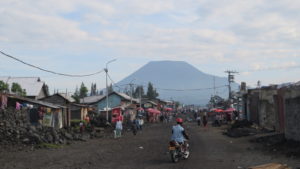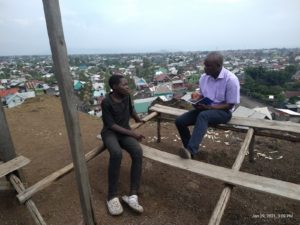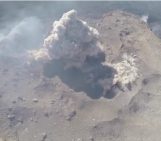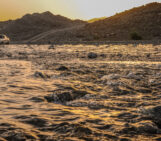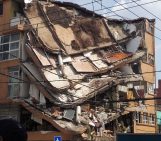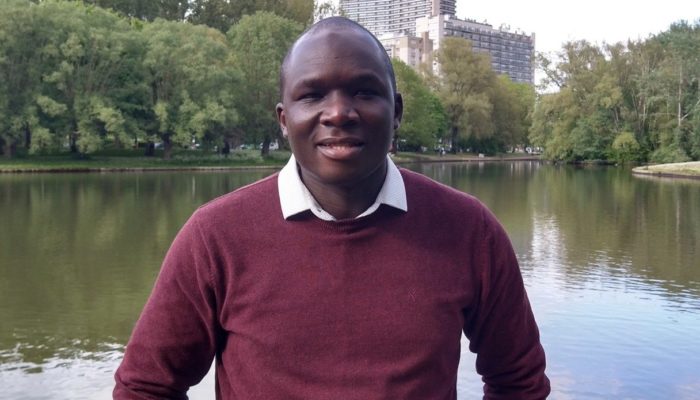
Thanks for joining us today Blaise! To begin, could you talk about your background and why you pursued research on people’s perceptions of natural hazards?
I have a background in geology and environmental sciences. Goma is my hometown and I work as a lecturer at the University of Goma. Living and working in a city built on lava flows and permanently threatened by several hazards from Nyiragongo volcano is a good reason to contribute to the effectiveness of the risk mitigation of more than 1 million inhabitants. The city had been severely impacted historically twice before my research, in 1977 and in 2002.
In general, the issue of risk mitigation is a permanent concern for the population of Goma. As Nyiragongo is an open system volcano, with regular gas plume and red glow at night, combined with some stigma of the 2002 lava flows that are still visible in some places, managing volcanic risk is a matter of public debate. Living in such an environment has influenced how the population of Goma perceive their risk, with their perception changing in both space and time. For example, before the 2021 eruption people living in the Est (historical path of lava flow) perceived the risk as being higher compared to those living in the West of the city. In addition, there are persistent rumours about risk in the city. Pursuing research on people’s perceptions of the volcanic hazard in Goma would help to better contextualise disaster risk reduction strategies in a context of political and economic instabilities.
Research has shown people can perceive their risk and vulnerability differently in relation to the same hazard. How does this happen?
People’s socio-economic vulnerability affects their perception of the risk. In principle, a high index of vulnerability generally leads to a high level of risk perception. For instance, living in a physically vulnerable house, people will be more concerned about the risk of earthquakes.
However, in Goma, prior to the May 2021 eruption, the vulnerable population in the peripheral neighbourhoods were also the ones who felt the least concerned by volcanic risks. This could be explained by the fact that social vulnerability is underpinned by the political context, armed conflicts, limited access to livelihoods and dependent economies, so that people are more concernced with daily survival than with natural hazards. Another explanation of the low perceived vulnerability among vulnerable people could be that they live far from the path of historical hazards or have suffered less in a previous disaster experience. In addition, the transfer of responsibilities in terms of mitigating the risk or a high trust in the authorities in charge of risk mitigation implies a low perceived vulnerability.
Why is considering the public’s perception important for mitigating or managing hazards and disasters?
Risk perception involves the processes of collecting, selecting, and interpreting signals about the uncertain impacts of volcanic hazards. Risk perception assessment determines why individuals differ in their perception of the same hazard, as well as how their risk perception may influence the risk mitigation implementation. In fact, people’s actions and reactions in the face of hazards are shaped by their perception. Risk perception is therefore an essential element to consider for effective risk management.
Scientists often hope their research will elicit behavioural change, but communicating on hazards can be difficult when you’re competing with different sources of information, authorities, and beliefs. How do you think experts such as yourself should communicate risk and hazards to the public?
Indeed, communicating on hazards can be difficult not only because of the competition between different communication sources, but also because of the low confidence in these communication channels, or even the capacity of the population to understand their key messages. Effective risk communication involves engaging with communities through two-way communication to ensure access to accurate, reliable and timely information.
It should therefore:
- Ensure that people have the life-saving information they need to protect themselves
- Ensure effective feedback mechanisms are in place and used to guarantee two-way communication between disaster risk reduction (DRR) authorities and communities
- Position national disaster risk reduction authorities as the main/first trusted source of information
- Ensure consistency in information and language from all stakeholders and avoid misinformation
- Inform the public on how the disaster risk reduction is being implemented
- Ensure the participation and commitment of affected communities to increase the uptake of mitigation measures and address barriers to their implementation
The 2002 eruption had left a strong impact on the population and for a few years after the eruption, the population had been particularly sensitized to this occasion. Almost twenty years later, before the eruption of May 2021, efforts had been reduced. Without proper and effective risk awareness, people can adopt behaviour that can put them at risk, which increases their vulnerability. Following the latest disaster in May 2021, it is essential that volcanic risk management in Goma integrates risk preparedness with effective, sustainable and ongoing awareness-raising tools. We are now testing two awareness raising tools implemented in Goma for secondary students: the HAZAGORA Game and a Museum of Volcanoes. We expect that these tools could increase the students’ knowledge about volcanoes and help prepare a future generation committed to risk mitigation in their communities.
Finally, what is your perception of your own future?
I see myself in the future as a lecturer and researcher working with the local community to find community-based risk mitigation solutions. It is my duty to educate and inform the population to hopefully have a future generation committed to disaster risk reduction.

